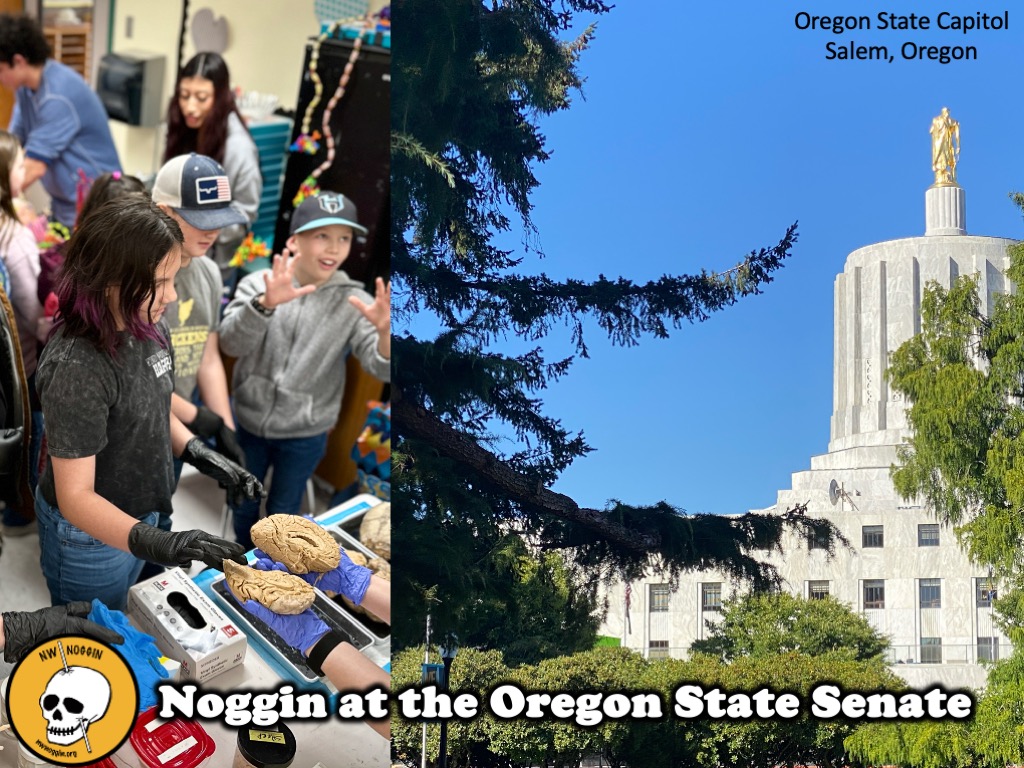NOTE: This is a post from 2024, when NW Noggin volunteers visited the Oregon State Capitol in Salem to present the research supporting ditching Daylight Savings and implementing the far healthier Permanent Standard Time.
We spoke again on this topic at a Senate hearing in March 2025.
We did it!
Northwest Noggin was honored and stoked by an invitation from Oregon State Senator Kim Thatcher to present neuroscience research on the clear community and individual health benefits of making standard time – not daylight savings time – permanent in Oregon.
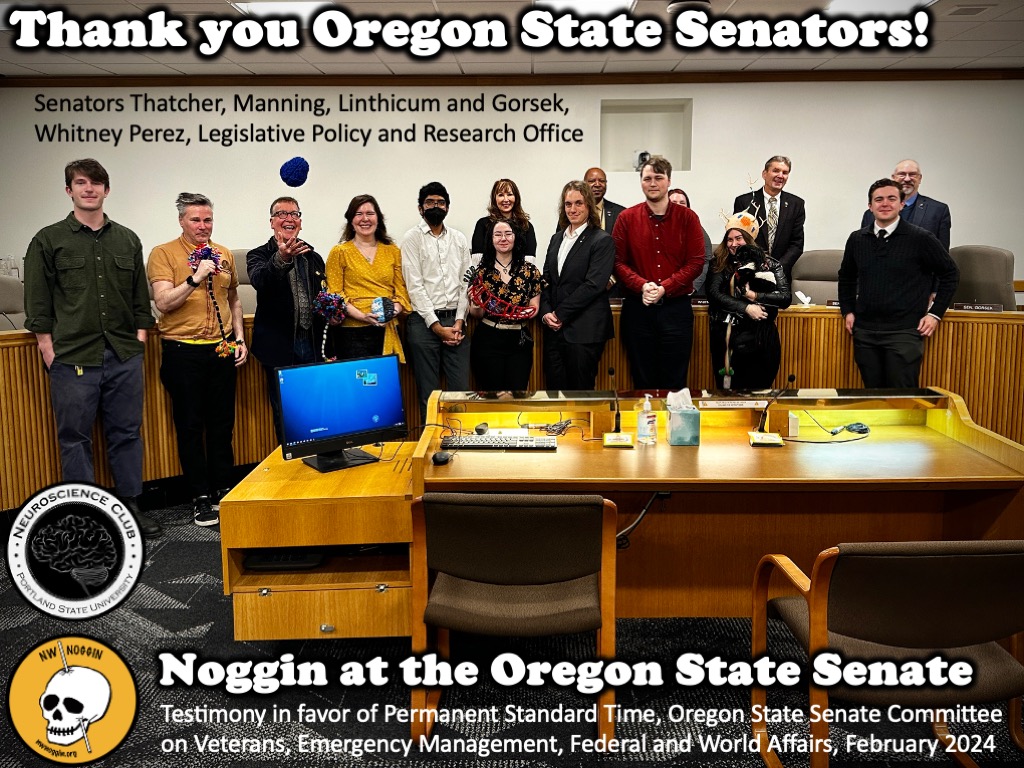
Our remarkable undergraduate and graduate students at Portland State University have dived deeply into this topic, one of great interest to the tens of thousands of K-12 students, teachers, school staff and other members of the public we’ve spoken with about sleep, mental health, and the impacts of time changes and light exposure over the last twelve years.
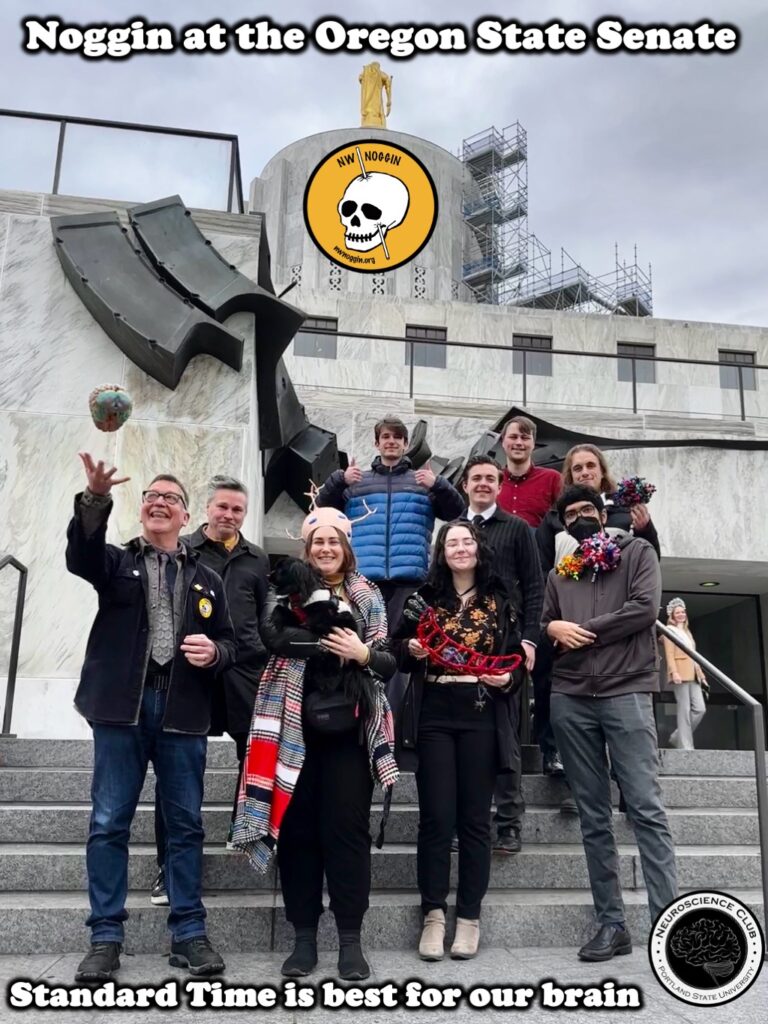
We excitedly traveled to Salem early this month to speak with the Senate Committee on Veterans, Emergency Management, Federal and World Affairs in the Oregon State Capitol during a short special session of the State Legislature.
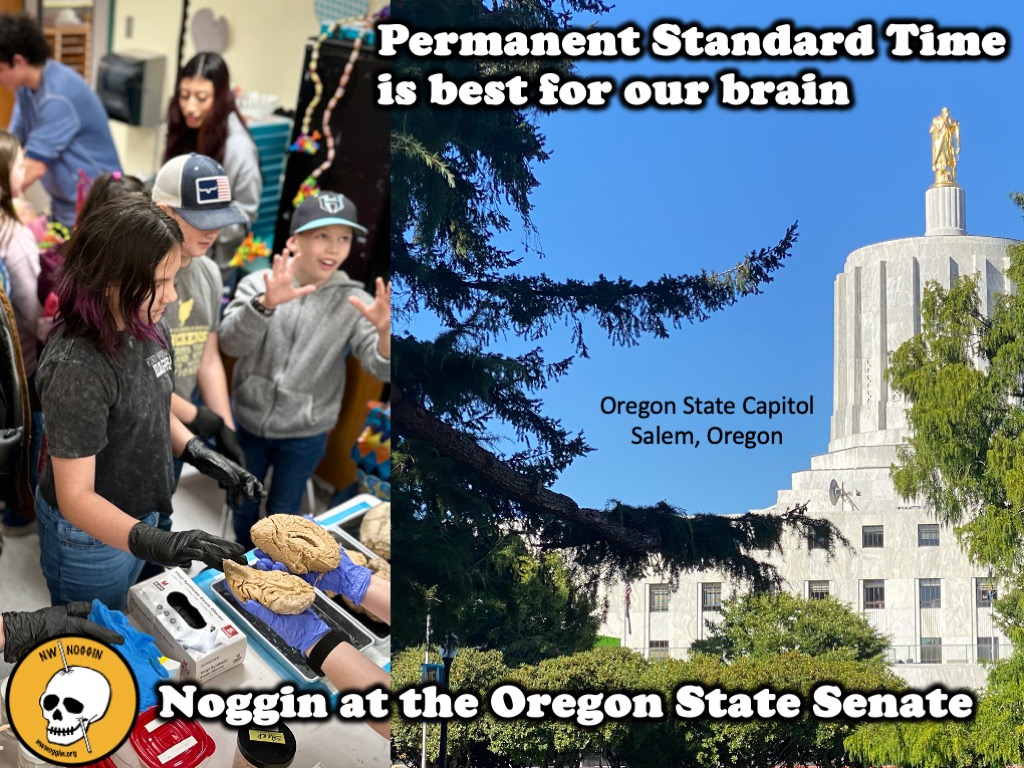
Read all about it! Article in the Statesman Journal!
Oregon may halt daylight saving time this year, without congressional approval

And in The New York Times!
Oregon Tries and Fails to Eliminate Daylight Savings Time, for Now

“Our ability to sleep well, as we know from experience, is profoundly impacted by exposure to light,” Bill Griesar, a teaching assistant professor at Portland State University, wrote in a public testimony this month. He added that standard time was “best aligned with the natural circadian rhythms of our own brains and bodies, allowing us to wake up more days of the year in sunlight.” (In other words: In permanent daylight saving time most people are probably commuting to work in the dark, but in standard time the sun is probably up around that time.)…
Please check out our Oregon Senate testimony below.
Introduction: Bill Griesar, Ph.D.
Tremendous thanks for this opportunity to share research this morning on the extensive community and mental health benefits of permanent standard time.
My name is Bill Griesar and I am a Teaching Assistant Professor of Interdisciplinary Neuroscience in the Department of Psychology at Portland State University. Along with my colleague Jeff Leake, I co-founded an entirely volunteer nonprofit called Northwest Noggin (nwnoggin.org), which brings together graduate students pursuing federally funded research and undergraduates studying the brain, along with art students and artists.

We regularly visit public K-12 classrooms, youth correctional facilities, houseless youth nonprofits (including p:ear, in Old Town Portland), museums, coffee shops, pubs, urban and rural communities, tribal majority schools – and even Congress – along with real brain specimens, and brain-related art projects – to hear what people already know about brains, and what they want to explore further. Over the last twelve years we’ve heard from over 65,000 Oregonians in Astoria, Redmond, Heppner, La Grande, Beaverton, Sisters, Grants Pass, Amity, Hillsboro, Warrenton, Hubbard, Willamina, Ione, Seaside, Siletz and more – to explore how our remarkable, changeable brains help make us who we are.

LEARN MORE: What is Northwest Noggin?
LEARN MORE: Synaptic Community Connections
LEARN MORE: Noggin Bloggin
One topic that comes up again and again across the state is the critical importance of sleep.
Sleep is essential for brain health. During good sleep, deep sleep, the kind of restorative sleep we all crave, the fluid surrounding our brain (known as cerebro-spinal fluid, or CSF) gets an opportunity to flush through the brain, literally cleaning it out. During deep, “slow wave” sleep, star-shaped brain cells called astrocytes, which gently wrap the small vessels (capillaries) delivering blood to brain tissue, pull back just a bit, allowing that CSF to reach deeply into every nook and cranny and actually remove many chemicals that build up because of all our metabolic activity during the day.
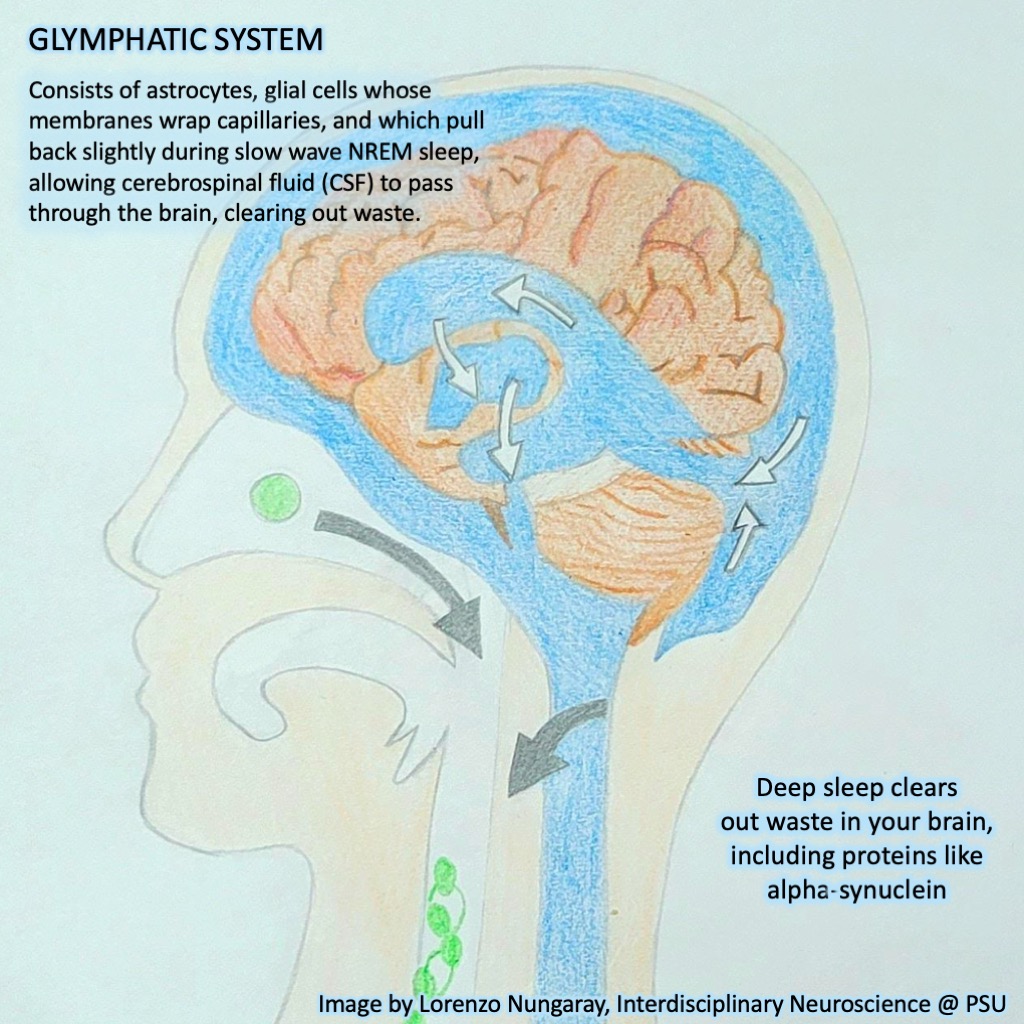
LEARN MORE: The Significance of Sleep
LEARN MORE: The Dynamic Relationship between the Glymphatic System, Aging, Memory, and Sleep
Our ability to sleep well, as we know from experience, is profoundly impacted by exposure to light. Permanent standard time is best aligned with the natural circadian rhythms of our own brains and bodies, allowing us to wake up more days of the year in sunlight.
Adolescents forced to rise in darkness (as many young people and parents know, this is not easy to do) are sleep-deprived, with serious consequences for brain development and mental health. Every major neurodegenerative disorder, including Parkinson’s, and Alzheimers disease – is preceded by about a decade of poor sleep. Permanent standard time is the policy supported by all the sleep research and medical organizations in the country, including the American Medical Association, the Sleep Research Society, the American Academy of Neurology, the American Academy of Sleep Medicine and more.
LEARN MORE: Light exposure behaviors predict mood, memory and sleep quality
LEARN MORE: AMA calls for permanent standard time
LEARN MORE: Permanent Standard Time: A Position Statement from the National Sleep Foundation
LEARN MORE: Changing Clocks to Daylight Saving Time Is Bad for Your Health
LEARN MORE: Adverse Effects of Daylight Saving Time on Adolescents’ Sleep and Vigilance
LEARN MORE: Study shows that teens lose sleep after change to daylight saving time
So today it’s my great pleasure to introduce some of our informed and enthusiastic Northwest Noggin volunteers who are eager to share relevant research, outreach and examples of effective policy change, including the adoption of permanent standard time, that will make Oregon a healthier state for all.
Legislative History: Kindra Crick
Thank you for inviting us. My name is Kindra Crick, I’m trained as a molecular biologist and currently make artwork and do outreach about sleep and memory. I’m a Board member with Northwest Noggin. I also have three school age children. We need healthy sleep all year long to maintain a robust immune system, metabolic health, alertness and a positive mood.

I’m here to talk about what we might learn from history about aligning or misaligning our social clock with the sun.
Russia conducted an experiment on its entire population from 2011 to 2014. Before 2011, like Oregon, they had a biannual switch removing an hour of sleep with the acute consequences the week following the annual ‘spring’ forward where heart attacks and car accidents temporarily increase. In 2011, to remove the ‘spring forward’ and ‘fall back’, Russia permanently switched to Daylight Saving Time or what they called “permanent Summertime”. In the depths of winter it was anything but! Waking up an hour earlier during the coldest and darkest time of the year robbed the entire population of the early morning sunlight that helps align our “body clock” with earth’s “solar clock.” The shift had negative influences on adolescents’ sleep habits, moods and behavior, with the most pronounced effects on those living in Russia’s northern latitudes. Citing health problems and a rise in early morning car accidents, in October 2014, Russia switched to permanent Standard Time and has been there for almost a decade.
The US already tried permanent daylight savings time before – and repealed it.
We also need to learn from our own history. In 1973, the United States wanted to save electricity during the national energy crisis. Congress instituted a plan for 16 months of continuous Daylight Saving Time nationwide, starting in 1974. It was wildly unpopular and was cut short after just 10 months with school officials in Florida blaming the deaths of six children in the first month on their having to go to school in darkness. It also did not have the promised energy savings.
Americans used to have their circadian rhythms aligned with the sun for eight more weeks. From 1976-1986 Daylight Saving Time started on the last Sunday in April. In 1987, Daylight Saving Time was from the first Sunday in April until the last Sunday in October.
In 2007 this was changed again, delaying sunrise for a longer portion of the year, changing the switch to the second Sunday in March and the first Sunday in November. These two changes decreased the duration of healthy Standard Time by about eight weeks from the mid-1970s.
Oregon needs to take the lead for its citizens’ health and safety and switch to year-round Standard Time as supported by organizations such as the American Academy of Sleep Medicine, American Academy of Cardiovascular Sleep Medicine, the National Safety Council, National PTA. Hawaii and Arizona have been on Standard Time for over 50 years and Oregon can do the same today, without an act of Congress.
LEARN MORE: The US wants to increase sleep deprivation and winter misery
“Results do not support claims that Daylight Savings Time (DST) reduces afternoon rush-hour accidents due to better illumination…”
— LEARN MORE: A Chronobiological Evaluation of the Acute Effects of Daylight Saving Time on Traffic Accident Risk
LEARN MORE: Impact of daylight saving time on road traffic collision risk: a systematic review
LEARN MORE: Living in the wrong time zone: Elevated risk of traffic fatalities in eccentric time localities
LEARN MORE: Daylight Saving Time Transitions: Impact on Total Mortality
Neuroscience and Policy Change: Marc Chenard
As a graduate student at Portland State University, and a volunteer at NW Noggin (nwnoggin.org), I support permanent standard time. I want to share some things I’ve learned about the neuroscience of sleep, developing brains, circadian health, and hope to provide you with a college student’s perspective on this policy.

Last spring I wrote and defended an honors thesis which compiled the neuroscience research supporting a potential start time shift to an hour later for high schools in the Vancouver Public School district. Based on that thesis and other volunteer efforts, Vancouver Public Schools made high schools start later, impacting just south of 10,000 teenagers. The school district was able to overcome logistical hurdles (like having to re-implement bus schedules and sports practices) in order to focus on supporting their students’ health and wellbeing (backed by neuroscience!).

LEARN MORE: Hey Vancouver: Let Kids Sleep!
In working on that thesis, and by doing neuroscience education outreach through NW Noggin, I have learned how essential adequate and regular sleep is to the mental health and performance of adolescent students. Permanent standard time in Oregon, and the sleep benefits that will accompany it, will have positive impacts on the health, well-being and success of Oregonian students.
Standard time leads to better alignment of our circadian rhythms which are regulated by exposure to low-angle morning sunlight. Exposure as soon as possible after waking helps synchronize many cellular processes with the external environment and this morning exposure is also a prerequisite for maintaining a consistent sleep-wake cycle.
This phenomenon is especially important to manage in teenage students due to a natural shift in circadian rhythms that occurs in the second decade of life during adolescence. This shift in the circadian rhythm of adolescents is well documented but not fully understood. There are many fascinating theories rooted in evolutionary biology that might explain why teenagers need to stay up later at night and sleep in later.
A high school start time shift that preceded the one in Vancouver Public Schools, documented in the study called ‘Sleepmore in Seattle’, indicated that even 45 minutes of extra sleep led to significantly decreased rates of diagnoses for depression, ADHD, anxiety and suicidal ideation in teenage students.
This to me demonstrates how any policy decisions that will promote better sleep for teenagers can be seen as a lever to improve their mental health and wellbeing.
Teenagers often get left out of discussions about the schedules they’re required to follow – even if those discussions have huge implications for their mental health and wellbeing. It’s important that we remember this and make policy decisions that stand to help Oregon’s teenage population.
Daylight savings time reduces student exposure to morning sunlight. This dramatically impacts levels of alertness and with that, the ability to learn. I remember showing up to high school in the dark and feeling groggy and ineffective. Missing out on morning sunlight also delays melatonin production at night making it harder for students to fall asleep. It’s not hard to imagine how this can cause a cycle where a student is always tired, perhaps experiencing a well-known condition called chronic sleep deprivation.
This cycle is further exacerbated in an era where blue light from phones is the norm for highschoolers until late at night which wasn’t a factor that required consideration in decades past.
There is ample research showing that adequate and regular sleep is essential for optimal brain function and learning, mood regulation, and overall well being. With these things in mind, NW Noggin and I support permanent standard time in Oregon.
We need to protect the health and wellbeing of our teenagers (along with all state citizens for that matter) and be open to solving logistical problems. Instead of fearing change or worrying about these logistical challenges, we need to enthusiastically push for a science-supported solution that supports our circadian health.
Natalie Robison
Hello everyone, good morning.
My name is Natalie Robison and I am a senior at Portland State University, pursuing neuroscience.
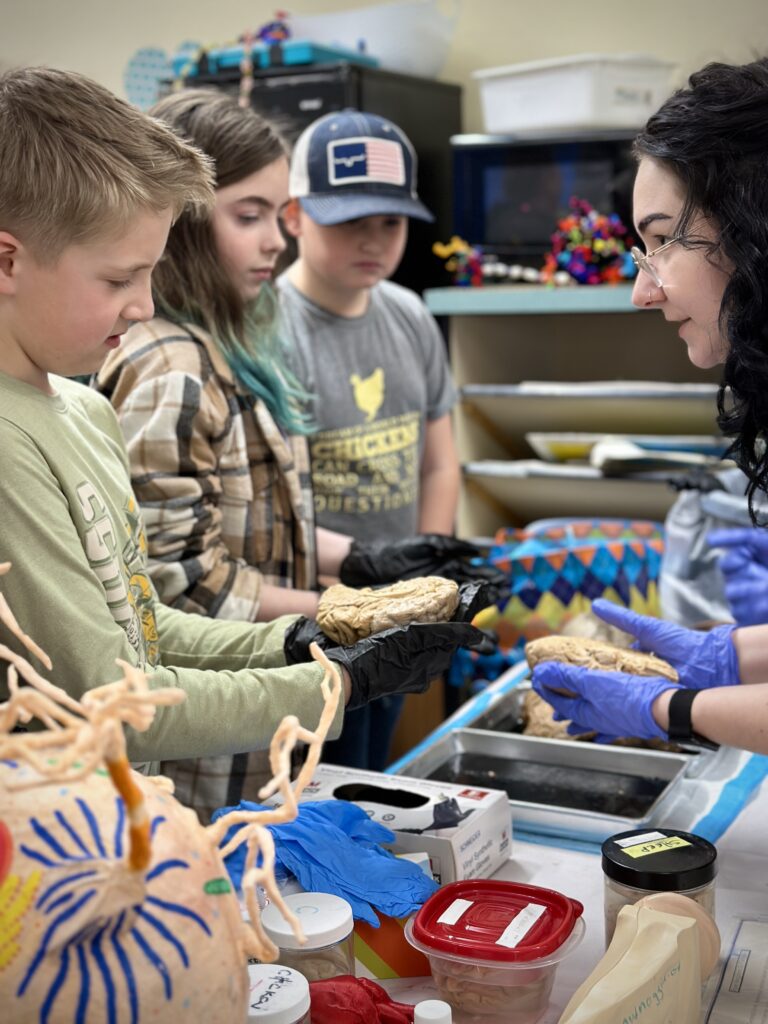
I’m not here today as a student, though. I am here as an individual with a delayed-onset circadian rhythm. Sleep as a biological process cannot be controlled, only influenced, and the best prescription for sleep health is consistency. My brain’s natural bed-time is 7:00 A.M., but I am here now for the chance of abolishing the dreaded daylight savings shift.
For those like myself with abnormal circadian rhythms, the adoption of permanent standard time enables more effective treatment because it unifies the timing of other hormonal processes throughout the day and night.
Instead, in three weeks I will begin my twice-yearly transition phase. I’ll offset my schedule of light therapy and medications in small increments around the time change, at risk of weeks of reduced sleep quality and a struggle to maintain my performance as I prepare to graduate.
I speak for adolescents who naturally share my position in their development, but who may lack the tools to address it. I appreciate your time and consideration of the abolition of daylight savings time in Oregon, and the adoption of permanent standard time, a change in our time system that I look forward to.
LEARN MORE: Delayed Sleep-Wake Phase Syndrome
LEARN MORE: Sleep timing and circadian phase in delayed sleep phase syndrome
LEARN MORE: Updates and confounding factors in delayed sleep–wake phase disorder
LEARN MORE: The impact of daylight-saving time (DST) on patients with delayed sleep-wake phase disorder (DSWPD)
Justin Benner
Ladies and gentlemen of Oregon’s Senate,
Thank you for the opportunity to share my thoughts related to the benefits of permanent standard time.
My name is Justin Benner, I am an undergraduate student in the Department of Psychology at Portland State University. I am an advocate for improving conditions in society related to neurology and psychology and have partnered with programs like Northwest Noggin, The Early Assessment Support Alliance (EASA), and EASA’s Young Adult Leadership Council (YALC) to improve education surrounding the brain, and the services associated with mental health. I consider it a great privilege to be able to speak to you today.

LEARN MORE: Treating the whole person
After reviewing the research and resources available on the benefits of adopting permanent standard time it is my firm position that doing so would be scientifically and statistically the best step in the right direction for improving the health and happiness of our state.
It is no secret that Oregonians struggle with depression; in fact, data pulled from 2020 by the Centers for Disease Control estimates that approximately 21% of Oregonians over the age of 18 struggle with depression. One of the main contributors to depression in the state is seasonal affective disorder or SAD for short. Research shows a link between waking up with light outside to a decrease in symptomatology of SAD by advancing the circadian rhythm which improves mood and energy levels throughout the day. Conversely waking up while it is still dark outside has been linked to delay in the circadian rhythm which has been shown to increase symptomatology and decrease areas previously mentioned.
As stated by Dr. Griesar adoption of permanent standard time would allow Oregonians to awake in sunlight more days of the year and reap the benefits that brings. I implore you to look over available resources to see just how much of a benefit adopting permanent standard time can bring to your communities through improving physical and mental health and come to your own conclusions.
Thank you again for your time and consideration in this matter. It is my hope that you take the words of those that have come forward today to heart and take action towards improving the lives of Oregonians through the adoption of permanent standard time.
Kadi Rae Smith
Hi, I’m Kadi Rae, an artist and neuroscience student at Portland State University.
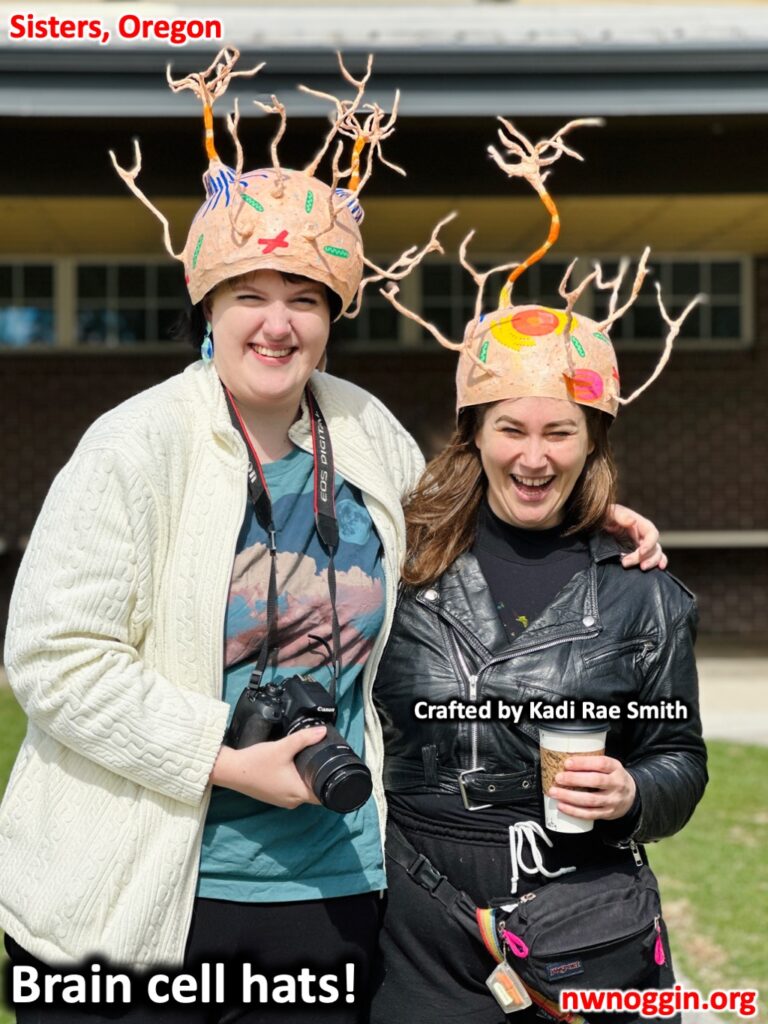
I’m also the Vice President of the PSU Neuroscience Club and like many of us, I have ADHD.
LEARN MORE: What is ADHD?
For neurodiverse people like myself, any change in our daily routine is challenging, but especially regarding sleep, which is vital for mental health management. We are heavily reliant on systems to function well, as our health (and sanity) are hinged on these daily regulations. Those of us with ADHD and Autism are like stick-shifts. What is automated for other people is manual for us, requiring constant regulation and know-how to keep from stalling out. Changes to our sleep patterns are very difficult to adjust to, and can kick-start or exacerbate depression and anxiety that are so often comorbid with neurodiversity, making the challenges we work through on a daily basis more difficult.
Thank you.
LEARN MORE: Associations of sleep disturbance with ADHD: implications for treatment
LEARN MORE: Depression in sleep disturbance: A review on a bidirectional relationship, mechanisms and treatment
Ben Bolen
My name is Ben Bolen and I’m a PhD candidate at Portland State, where I create robots that use artificial muscles to study neuromuscular control. I’m president of PSU’s Neuroscience Club, which is the university’s most active club. I’m also a volunteer with NW Noggin, FIRST robotics, and MESA. And very recently my first child was born.
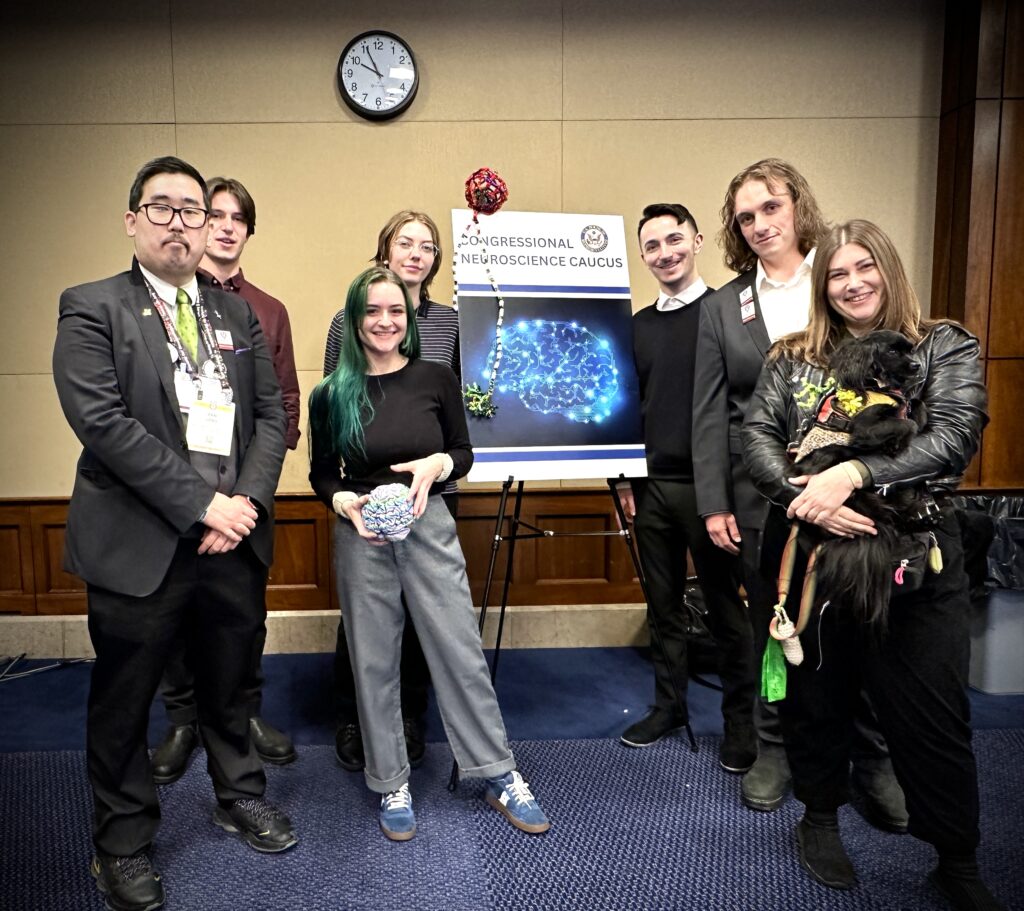
I’ve always considered myself somewhat of a night owl even though I understand humans are diurnal creatures. I never really saw the purpose of changing between Daylight Savings Time and Standard Time. If you’d asked me a few months ago, my gut reaction would have been to join the permanent DST bandwagon. However, seeing how my child’s circadian rhythm develops, and noticing the changes in myself as I’ve adjusted to their schedule, I do see and feel the benefits of keeping Standard Time. But more than this anecdote, the evidence is clear: DST has negative impacts on individual health and society, whereas keeping permanent Standard Time is better for us.
Alexis Gonzalez
Ladies and Gentlemen of the Committee, good morning to you all. My name is Alexis Gonzalez, communications officer for the Neuroscience Club at Portland State University.
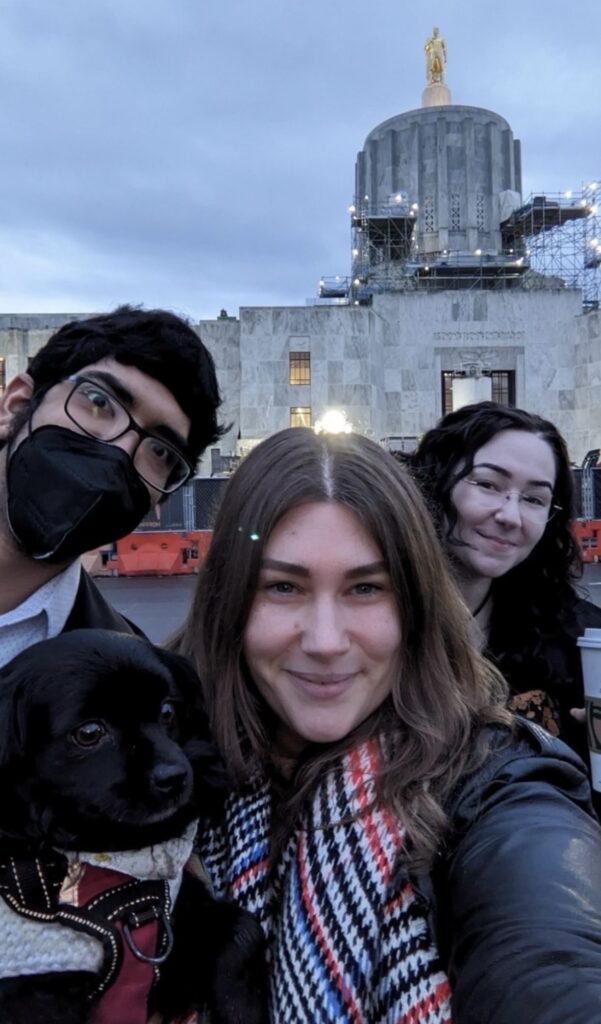
I have ADHD, and have recently moved from Arizona to the wonderful state of Oregon. Arizona is one of two states without Daylight Savings implemented alongside Hawaii. As such, the concept of Daylight Savings is largely foreign to me, and the adjustment has been draining. This has been evidenced by physiological responses in my body to the arbitrary time adjustment, an adjustment that has thrown several aspects of my life off-balance, personally, professionally, and academically. Where I normally am able to perform my tasks at work at peak efficiency, consistently turn in assignments, and organize social gatherings with ease, I now struggle to keep up due to the fact that I no longer am running by a clock that I have grown used to.

LEARN MORE: Daylight saving: Why these two states didn’t change their clocks this morning
Indeed, anecdotal reports I have received from multiple colleagues in California, Oregon, Washington, and Arizona have all come to similar conclusions. Time is valuable, and a sudden change in it is not only useless, but causes far more harm than help.
Several studies have found an increase in vehicular collisions during the period of time that Daylight Savings is put into effect, particularly after transitions. Due to our physiological clocks being inhibited by a sudden change to routine, a normally alert and competent individual is suddenly handicapped physically and psychologically as they struggle to adapt to the change.
The relationship between crash rates and time changes is complex (see research links below); however our current approach can have real and disastrous consequences, with increased collisions being a financial and health hazard to the citizens of this state and country.
LEARN MORE: Fatal accidents following changes in daylight savings time: the American experience
LEARN MORE: Traffic accident increase attributed to Daylight Saving Time doubled after Energy Policy Act
LEARN MORE: Driving simulator performance worsens after the Spring transition to Daylight Saving Time
Therefore, on behalf of our fellow student body, coworkers, and citizens, we advocate that Daylight Savings be abolished and standard time is made permanent.



